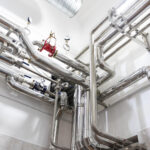Fire protection is a critical aspect of safeguarding residential properties in Texas. With the state’s diverse climate and the potential for wildfires, it is crucial for building owners to prioritize effective fire protection solutions. The safety of residents, property value, and compliance with local regulations all hinge on implementing the right measures.
Fire incidents can have devastating consequences, leading to loss of life, property damage, and financial setbacks. As a building owner in Texas, understanding the importance of fire protection is the first step towards ensuring the safety and well-being of your property and its occupants.
Texas experiences a range of weather conditions, from scorching heat to unpredictable storms. These factors contribute to the elevated risk of fires, making it imperative for residential property owners to adopt comprehensive fire protection measures. Implementing these solutions not only protects lives but also preserves the investment you’ve made in your property.
Table of Contents
Assessing the Risks and Vulnerabilities of Residential Properties
Before choosing the best fire protection solutions, it is essential to conduct a thorough assessment of the risks and vulnerabilities specific to your residential property. Factors such as the surrounding landscape, proximity to potential ignition sources, and the materials used in construction all play a role in determining the level of risk.
Start by evaluating the landscape around your property. Texas is known for its wild grasses and shrubs, which can become potential fuel for wildfires. Assess the distance between your property and any vegetation that may pose a risk during dry seasons. Understanding these factors will help you tailor your fire protection measures to address the specific threats your property faces.
Next, consider the construction materials used in your building. Fire-resistant materials can significantly enhance your property’s ability to withstand a fire. Additionally, identifying potential ignition sources within and around the property allows you to implement preventative measures.
Choosing the Right Fire Protection Solutions
1. Fire-Resistant Building Materials
Selecting fire-resistant building materials is a foundational step in enhancing the fire protection capabilities of your residential property. Materials such as fire-rated drywall, intumescent coatings, and fire-resistant roofing materials can mitigate the spread of flames and increase the overall fire resistance of your building.
Investing in these materials not only contributes to the safety of your property but also aligns with local building codes and regulations. Using fire-resistant materials is a proactive approach to minimizing the risk of fire-related damage and ensuring the longevity of your investment.
2. Firebreaks and Defensible Space
Creating defensible space around your property acts as a natural barrier against wildfires. This involves clearing vegetation, creating firebreaks, and strategically placing landscaping features to impede the spread of flames. The goal is to establish a buffer zone that prevents the fire from reaching the structure, giving firefighters a better chance to control the blaze.
Collaborate with local fire authorities to determine the most effective defensible space measures for your specific location. Their expertise can guide you in implementing practical and sustainable solutions that align with the unique challenges posed by the Texas climate.
3. Fire Detection and Alarm Systems
Early detection is crucial in minimizing the impact of a fire. Installing state-of-the-art fire detection and alarm systems ensures that any potential threat is identified promptly, allowing for swift evacuation and intervention. Choose systems that integrate smoke detectors, heat sensors, and alarms to provide comprehensive coverage throughout your residential property.
Regular maintenance and testing of these systems are paramount to their effectiveness. Partner with reputable fire protection service providers to establish a routine maintenance schedule, ensuring that your detection and alarm systems remain in optimal condition.
4. Fire Suppression Systems
In addition to early detection, having reliable fire suppression systems in place is essential. Depending on the size and layout of your residential property, consider installing sprinkler systems, fire extinguishers, or other suppression measures. These systems can help contain a fire until professional help arrives, reducing the potential for extensive damage.
Engage with fire protection experts to assess the specific needs of your property and determine the most suitable suppression systems. Adequate training for residents on how to use fire extinguishers is also an integral part of an effective fire protection strategy.

Maintaining and Updating Fire Protection Measures
Implementing fire protection measures is not a one-time task; it requires ongoing commitment and diligence. Regular maintenance, updates, and adherence to evolving safety standards are essential to ensuring the continued effectiveness of your fire protection systems.
Regularly inspect and test your fire detection and alarm systems to identify any issues promptly. Stay informed about advancements in fire protection technology and consider upgrading your systems to incorporate the latest innovations. Collaborate with local fire authorities to stay abreast of any changes in regulations that may impact your fire protection strategy.
Additionally, conduct periodic assessments of the defensible space around your property. As the landscape changes and matures, adjustments to firebreaks and vegetation management may be necessary. Stay proactive in addressing potential vulnerabilities and make necessary modifications to enhance the overall resilience of your residential property.
Conclusion
As a responsible building owner in Texas, prioritizing fire protection is an investment in the safety and longevity of your property. By understanding the unique risks posed by the Texas climate and landscape, you can tailor your fire protection measures to address specific vulnerabilities.
From choosing fire-resistant building materials to creating defensible space and implementing state-of-the-art detection and suppression systems, every measure contributes to a comprehensive fire protection strategy. Regular maintenance and updates ensure that your systems remain effective over time, providing peace of mind for both you and your residents.
Remember, fire protection is not only about compliance with regulations but, more importantly, about safeguarding lives and property. By adopting a proactive approach and staying committed to ongoing safety measures, you contribute to a safer and more resilient community in the heart of Texas.




